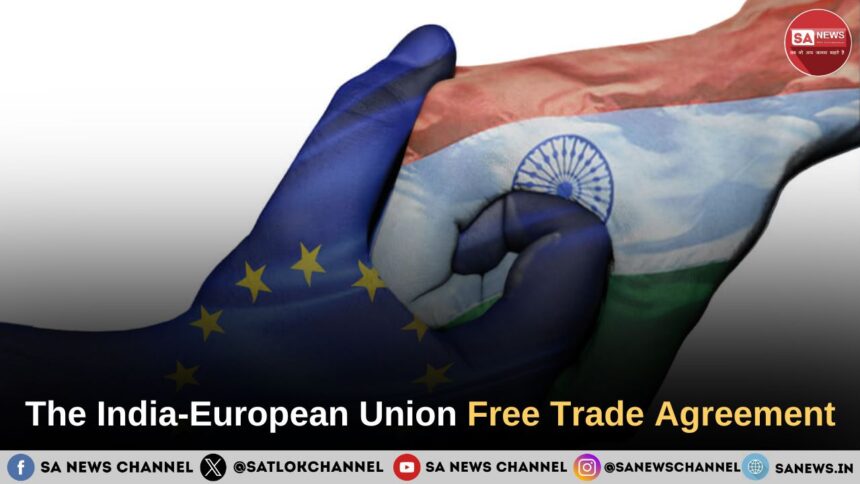The India-European Union (EU) Free Trade Agreement (FTA) is one of the most anticipated trade deals in the global economic landscape. First proposed in 2007, this agreement aims to create a stronger economic partnership between two of the world’s largest economies. After several rounds of negotiations and pauses, talks have gained momentum again in recent years, with both sides realizing the importance of closer India EU trade relations in a rapidly changing global order.
- Current Trade Figures and India-EU Economic Ties
- Main Points of Negotiation in the India-EU FTA
- 1. Tariff Reductions
- 2. Investment Protection
- 3. Intellectual Property Rights (IPR)
- 4. Sustainable Development
- Benefits of the India-EU Free Trade Agreement
- Conclusion: A Strategic Step Toward a Stronger Partnership
The India EU FTA is likely to boost trade, improve market access, and support economic growth as the world faces economic challenges, supply chain issues, and geopolitical conflicts. But what exactly does this agreement involve, and why is it so important? Let’s take a closer look.
Current Trade Figures and India-EU Economic Ties
India and the EU share a long-standing trade relationship. The European Union is India’s third-biggest trading partner, and India is one of the EU’s top 10 trade partners.
Trade Snapshot (as of 2023):
- Total bilateral trade: Over €120 billion
- EU exports to India: Mainly machinery, vehicles, chemicals, and pharmaceuticals
- The European Union is India’s third-biggest trading partner, and India is one of the EU’s top 10 trade partners.
Beyond goods, services trade and foreign direct investment (FDI) are key pillars. The EU is one of the largest investors in India, accounting for around 16% of total FDI inflows.
Also Read: Trump Imposes 145% Tariffs on Chinese Imports: What It Means for Global Trade
Despite these strong figures, both sides agree there’s room to grow. That’s where the India EU FTA comes in — aiming to lower trade barriers, enhance cooperation, and tap into untapped potential.
Main Points of Negotiation in the India-EU FTA
The India-EU Free Trade Agreement is being designed as a comprehensive deal, covering a wide range of economic and regulatory issues. Below are the key areas under negotiation:
1. Tariff Reductions
India sells textiles, organic chemicals, gems and jewelry, and engineering products to the EU.
- Example: Currently, India imposes high import duties on European wine and automobiles. The EU, in turn, has tariffs on Indian textiles and footwear. Under the FTA, both parties aim to lower these tariffs to make goods more affordable and competitive.
Tariff reductions will not only benefit large businesses but also consumers, who can enjoy a wider variety of products at lower prices.
2. Investment Protection
Investment is another major pillar of the FTA. The agreement seeks to establish a secure and predictable environment for investors on both sides.
- The proposed Investment Protection Agreement will safeguard investors against unfair treatment, expropriation, and provide mechanisms for dispute resolution.
This is particularly important for boosting confidence in long-term economic partnership and encouraging more European companies to invest in India and vice versa.
3. Intellectual Property Rights (IPR)
The EU strongly focuses on enforcing intellectual property rights. For India, balancing IPR with affordable access to medicines and technology is a delicate issue.
- The FTA will likely include commitments on trademarks, patents, and geographical indications, while taking into account India’s developmental needs.
4. Sustainable Development
Both India and the EU recognize the importance of sustainability. The FTA will include chapters on environmental protection, labor rights, and responsible business conduct.
- The goal is to ensure that economic growth does not come at the cost of the planet or human rights.
Benefits of the India-EU Free Trade Agreement
For Businesses
- Better Market Access: Reduced tariffs and clearer regulations mean Indian and European companies can enter each other’s markets more easily.
- Increased Investment: With stronger legal protections, companies are more likely to invest and expand operations.
- Supply Chain Integration: Businesses can benefit from smoother supply chains and access to key resources.
For Consumers
- Lower Prices: Reduced import duties mean cheaper products ranging from electronics to clothing.
- Greater Variety: Consumers will have access to a wider range of high-quality European and Indian products.
- Higher Standards: With improved regulation and competition, product quality and safety standards are likely to improve.
Conclusion: A Strategic Step Toward a Stronger Partnership
The India-European Union Free Trade Agreement has the potential to be a game-changer in global trade. By addressing key issues such as tariff reductions, investment protection, and sustainable development, it promises to deepen India EU trade relations and unlock new opportunities for both regions.
As negotiations progress, both sides must find a balanced approach that supports economic growth, protects public interest, and fosters innovation. For businesses, investors, and consumers alike, the India EU FTA represents a strategic step toward a more connected and prosperous future.
The goals of the India-EU Free Trade Agreement—such as equitable trade, sustainable development, and investment protection. Sant Rampal Ji Maharaj emphasizes the importance of true spiritual knowledge (gyan) in creating a just, peaceful, and prosperous society. His teachings advocate fairness, truth, and ethical living.
Just as spiritual enlightenment leads to harmony in life, a fair and transparent economic agreement fosters balanced India EU trade relations. Both aim to reduce conflict and promote mutual benefit. In this way, the FTA reflects some of the core principles found in Sant Rampal Ji’s gyan—peace, justice, and collective progress.









